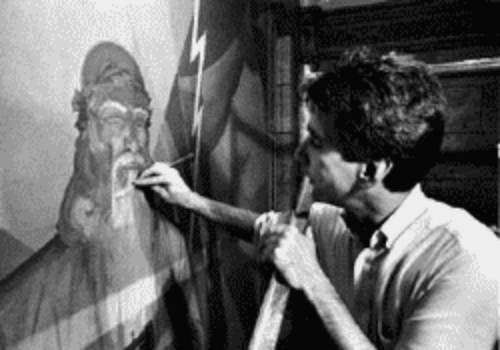Telecommunications History Group Resources
931 14th St. Historic Building
Allen Tupper True Murals
 The murals in the 931 14th St. building celebrate the technology of the telephone, the genius of those who contributed to its development, and the hard-working men and women who provided service to the public. They were created by the preeminent Colorado artist Allen Tupper True.
The murals in the 931 14th St. building celebrate the technology of the telephone, the genius of those who contributed to its development, and the hard-working men and women who provided service to the public. They were created by the preeminent Colorado artist Allen Tupper True.
Allen Tupper True (1881-1955) was born in Colorado Springs, Colorado. He was a student at the University of Denver and studied at the Corcoran School of Art in Washington, D.C. between 1901 and 1902. In 1902, he was accepted into Howard Pyle’s classes in Chadd’s Ford and through Pyle began his career as a magazine illustrator. From approximately 1913 through 1915, True assisted British muralist Frank Brangwyn with murals at the Panama-Pacific Exposition in San Francisco, California.
His most notable works include the mural decorations in the state capitol buildings of Colorado, Missouri, and Wyoming, as well as murals for the Civic Center and the Mountain States Telephone and Telegraph Company Building in Denver, Colorado. Other True murals can be seen in the Brown Palace Hotel, Denver Civic Center Park, and the Colorado National Bank. He also designed the decoration and color schemes for the Boulder Dam power plant, Grand Coulee Dam, Shasta Dam, and others.
Allen Tupper True’s papers are available online at the Smithsonian Institution, here: www.aaa.si.edu/collections/findingaids/truealle.htm
The murals in the telephone building were subject to the same problems any outdoor art seems to have over the decades in a city: pollution, dirt, and grafitti slowly take their toll. Several attempts were made to restore the murals over time, but the first several of these were as bad as the problems they were trying to solve, as “restorers” merely painted over the grime with whatever paints were at hand. Some of the images were even altered slightly by those working on them.
Finally, in the 1980s, the telephone company hired the Rocky Mountain Conservation Center to restore the murals properly. This group came in and carefully removed the “new” paint, the dirt underneath, the grafitti, and all the other wear and tear. Then they restored the murals to their original imagery and colors, using paint mixed as it would have been in the 1920s. This did wonders for the beauty of the murals. Now, twenty years later, Qwest has had the murals cleaned again.
The murals are further described at the following links. Please note that the italicized text accompanying them is adapted from a 1929 pamphlet put out by the telephone company to promote the murals and the building.
Finally, in the 1980s, the telephone company hired the Rocky Mountain Conservation Center to restore the murals properly. This group came in and carefully removed the “new” paint, the dirt underneath, the grafitti, and all the other wear and tear. Then they restored the murals to their original imagery and colors, using paint mixed as it would have been in the 1920s. This did wonders for the beauty of the murals. Now, twenty years later, Qwest has had the murals cleaned again.
The murals are further described at the following links. Please note that the italicized text accompanying them is adapted from a 1929 pamphlet put out by the telephone company to promote the murals and the building.


